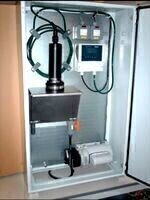Water/Wastewater
Turbidity Monitoring at Halecombe Quarry
Oct 03 2008
In order to operate an effective water discharge facility, it is necessary to have a constant overview of how the treatment or natural settlement processes are functioning. This is best performed by investing in instruments that are purpose-designed for specific duties.
Suspended Solids and Turbidity are key parameters for assessing the quality of the effluent in respect of meeting consent levels. They are also indicators of the basic performance of the treatment works and of any problems that are causing solids to leave the site and enter the watercourse or sewer network. An increase in the level of final effluent suspended solids is an indicator to plant operators that a problem has occurred in the treatment system, such as poor settlement due to excessive flow or failure of a biological process. However, for those sites without a treatment works and where excess water is discharged or allowed to run off from several locations, fixed instrumentation giving real-time results is not always a feasible option. Nor for that matter is the process of gathering liquid samples
for later analysis in a laboratory.
Quarrying limestone at Halecombe in the Mendip Hills has taken place since the late 1940`s and today annual output from the quarry is
between 600,000 and 700,000 tons of crushed aggregate products. It is not one of the largest quarries in the area but its owners Tarmac
Southwest takes its environmental responsibilities very seriously, ensuring that the local brook feeding the adjacent River Mells remains in pristine condition and of course, the EA consent levels are
never breached.
At Halecombe Quarry, plant operatives have used Partech`s (UK) portable turbidity instruments for several years to check that they are not in
breach of, or are likely to breach, their consent level of 60mg/l suspended solids. This method has always been backed up by a laboratory
collecting samples for off-site analysis. At the start of 2008, Halecombe Quarry switched to fixed instrumentation in the form of Partech`s MCERTS approved 7200 monitor and TurbiTech 2000LS analyser located in a flow cell close to the discharge outlets.
Over the years, the Halecombe Quarry has gone through a number of sumps and as the quarry has gone deeper and another sump created, an area has needed to be excavated to hold water coming into the site. The problem is that this has eventually led to almost a third of the quarry`s reserves being tied up in dewatering sump capacity. Rather than operating a purpose built treatment plant to remove solids, Tarmac
Southwest has always allowed solids to settle in these dewatering sumps from where the water is pumped up to the top of the quarry and discharged to the adjacent brook. By performing turbidity analysis with portable instruments at regular intervals, operators have been able to
stop pumping if turbidity levels have increased.
In order to free up more reserves of limestone a completely new dewatering sump was created in 2007 and is currently holding around 250,000m² of water. It was this development that lead to Tarmac Southwest reviewing its turbidity analysing process. The outcome has been the installation of a fixed Partech 7200 Monitor and TurbiTech 2000LS system using telemetry to interface with the pumps in the dewatering sump.
The Partech system is installed in a robust cabinet fitted with water sampling line and sampling cell into which the TurbiTech sensor is
inserted. The Partech sensor uses infrared light that is either scattered or absorbed by the particles in suspension, with the amount of received light being proportional to the level of suspended
solids. The amount of received light is converted into Suspended Solids by the 7200 Monitor using algorithms that have been developed specifically for these applications.
“We turned to Partech because of our past satisfactory experience with their products,†reports Zone Operations Manager Daniel Brailsford. “We did look at other products, but Partech were able to demonstrate to us that they understood the application and also had a product that was MCERTS approved. MCERTS is not a requirement for the quarry, but because the EA does monitor what we do, we wanted to make sure that we adhered to their approved equipment. Partech were very professional in he level of service provided to us, their input extending to providing installation and tying their equipment into the new pump control system.â€
Moving from portable to permanent fixed monitoring will improve the Quarry`s controllability because it directly controls the pumps and if there is an issue the pumps cut out automatically. In order to control energy costs, dewatering is only carried out at times of the day when energy charges are lower and by having ultrasonic water level controls, the Quarry is only pumping water when it is necessary.
“We are restricted to discharging 16,000³m per day,†says Daniel Brailsford, “and we want to be able to prove that we are taking every precaution to ensure that we are not creating any problems by breaching our consent levels.
I understand that this is the first quarry in the UK to have such a sampling and pump control system.
The whole of the quarrying industry is becoming much more aware of its environmental responsibilities and with this new monitoring and pump control system here at Halecombe we are demonstrating our commitment to sound environmental practices.â€
Digital Edition
IET 34.2 March 2024
April 2024
Gas Detection - Biogas batch fermentation system for laboratory use with automatic gas analysis in real time Water/Wastewater - Upcycling sensors for sustainable nature management - Prist...
View all digital editions
Events
Apr 30 2024 Melbourne, Australia
Apr 30 2024 Birmingham, UK
May 03 2024 Seoul, South Korea
May 05 2024 Seville, Spain
May 06 2024 Minneapolis, MN, USA


















